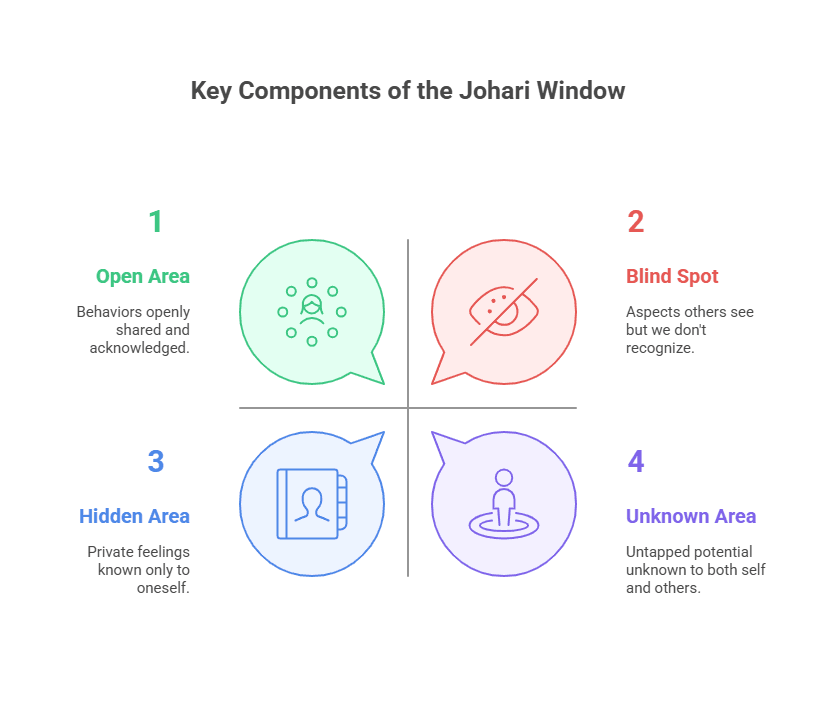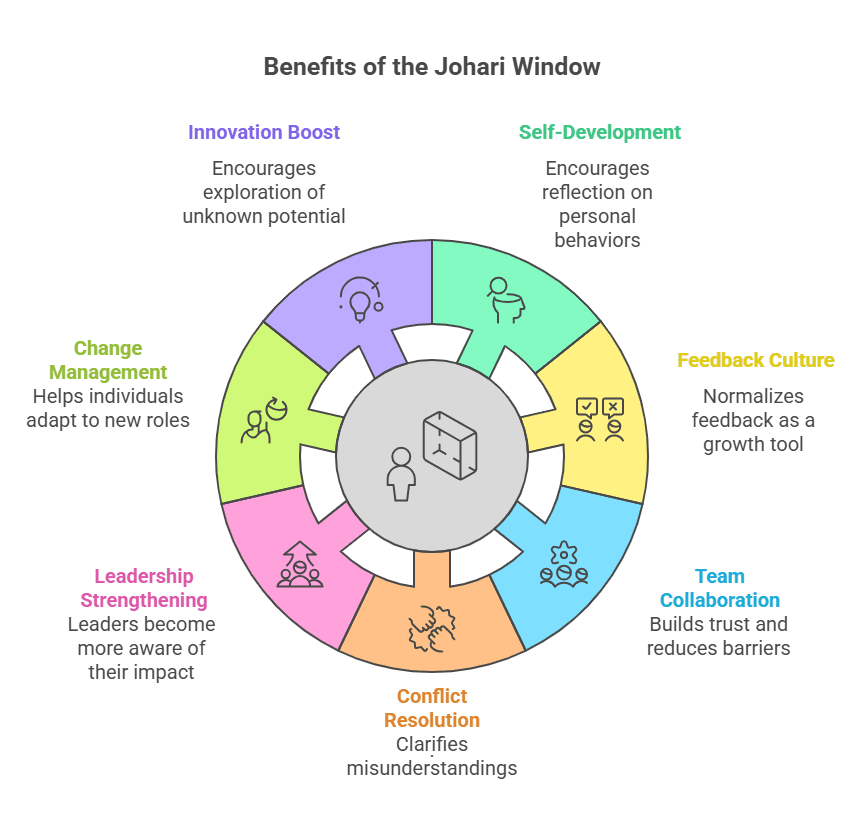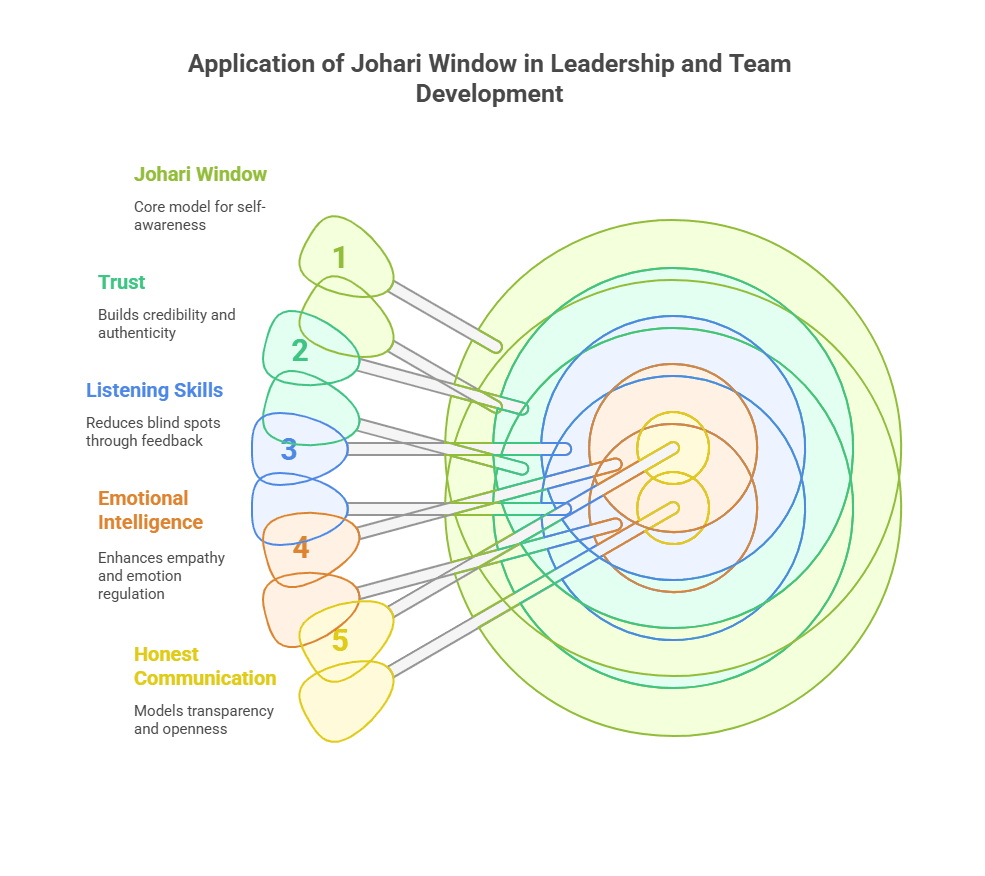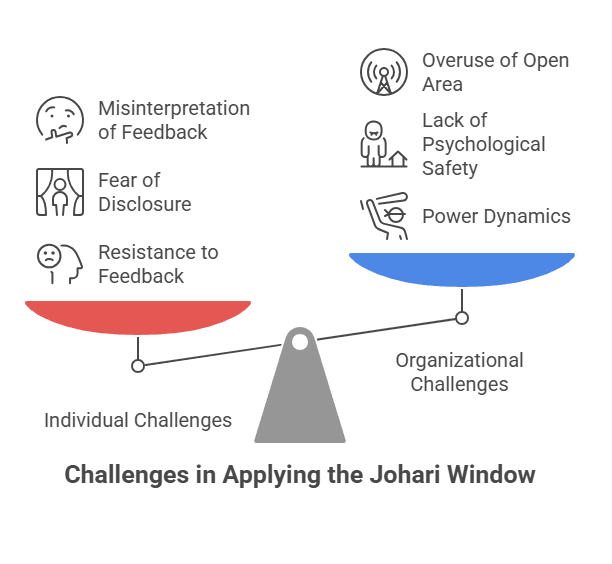In the complex landscape of organizational behavior, effective interpersonal relationships are the foundation of successful teams and high-performing individuals. The Johari Window is a powerful psychological and communication tool developed by Joseph Luft and Harrington Ingham in 1955 to help individuals understand their interpersonal relationships and self-awareness. Named by combining their first names, this model is widely used in management, coaching, counseling, and personal development to enhance communication and trust in group settings.
Introduction to the Johari Window
The Johari Window is a simple yet profound framework that explores how individuals perceive themselves and how they are perceived by others. It facilitates self-disclosure, feedback exchange, and personal growth. The model divides personal awareness into four quadrants and provides insights into the dynamics of interpersonal communication.
Key Points:
- Developed to improve self-awareness, mutual understanding, and communication.
- Consists of four quadrants representing different types of personal knowledge.
- Encourages individuals to share and receive feedback to build trust.
- Widely applied in team development, leadership training, and psychotherapy.
By making hidden areas visible, the Johari Window enhances clarity in relationships and team dynamics.
Key Components of the Johari Window
The Johari Window model is represented by a four-quadrant grid that reflects varying levels of self-awareness and interpersonal communication.

The Four Quadrants:
- Open Area (Arena): Known to self and others. This includes behaviors, knowledge, skills, and attitudes openly shared and acknowledged.
- Blind Area (Blind Spot): Known to others but not known to self. It represents aspects others see in us but we fail to recognize.
- Hidden Area (Facade): Known to self but not to others. This includes private feelings, fears, or experiences.
- Unknown Area: Unknown to both self and others. It contains untapped potential, repressed memories, or unconscious behaviors.
Highlights:
- Expanding the Open Area improves transparency and trust.
- Reducing the Blind Area enhances self-awareness through feedback.
- Reducing the Hidden Area fosters openness and authenticity.
- Exploring the Unknown Area can lead to personal breakthroughs and innovation.
Understanding these quadrants helps individuals and teams enhance communication and reduce misunderstandings.
Role of Johari Window in Enhancing Interpersonal Relationships
The Johari Window supports individuals in building more authentic and meaningful relationships through feedback and self-disclosure. It encourages a culture of openness and psychological safety.
Contributions to Interpersonal Relationships:
- Encourages mutual understanding and empathy.
- Builds trust by increasing transparency.
- Promotes honest and respectful communication.
- Facilitates effective feedback mechanisms.
- Reduces misinterpretations and assumptions.
- Enhances personal accountability and integrity.
Highlights:
- Useful in coaching and mentoring relationships.
- Helps teams build strong, cohesive working relationships.
- Fosters an inclusive environment by acknowledging diverse perspectives.
By encouraging open communication, the Johari Window transforms surface-level connections into deep, productive relationships.
Importance of the Johari Window in Organizational Settings
In organizations, the Johari Window model plays a critical role in team development, leadership, and communication enhancement. It helps teams become more self-aware, cohesive, and effective.

Organizational Benefits:
- Promotes Self-Development: Encourages employees to reflect on their behaviors.
- Improves Feedback Culture: Normalizes feedback as a growth tool.
- Enhances Team Collaboration: Builds trust and reduces barriers.
- Supports Conflict Resolution: Clarifies misunderstandings rooted in blind spots or assumptions.
- Strengthens Leadership: Leaders become more aware of their impact and communication style.
- Facilitates Change Management: Helps individuals adapt to new roles or teams.
- Boosts Innovation: Encourages exploration of unknown potential.
Highlights:
- Applicable in team-building workshops and performance reviews.
- Particularly useful during team formation and organizational change.
- Empowers diverse teams to communicate across cultural or personal differences.
The Johari Window not only supports individual growth but also strengthens organizational culture and cohesion.
Application of Johari Window in Leadership and Team Development
Effective leadership is grounded in emotional intelligence and self-awareness—qualities fostered by the Johari Window. Leaders and managers use this model to guide team development and performance enhancement.

Leadership Applications:
- Developing Trust: Leaders who expand their open area are perceived as authentic and credible.
- Improving Listening Skills: Understanding others’ feedback reduces blind spots.
- Empowering Teams: Team members feel more valued when their input is acknowledged.
- Enhancing Emotional Intelligence: Helps leaders regulate emotions and empathize with others.
- Encouraging Honest Communication: Leaders model transparency by sharing relevant information.
Highlights:
- Leaders use the model in coaching conversations and performance discussions.
- It promotes shared understanding of team norms, goals, and behaviors.
- Facilitates effective delegation and conflict management.
The Johari Window enables leaders to foster an environment of openness, learning, and mutual respect.
Challenges in Applying the Johari Window
Despite its simplicity, using the Johari Window effectively requires emotional maturity, trust, and a willingness to change. Several challenges can emerge during its application.

Common Challenges:
- Resistance to Feedback: Individuals may feel threatened or criticized.
- Fear of Disclosure: People may hesitate to share personal insights or vulnerabilities.
- Cultural Differences: Norms around openness vary across cultures.
- Power Dynamics: Hierarchical structures can suppress honest communication.
- Misinterpretation of Feedback: Feedback may be taken personally rather than constructively.
- Lack of Psychological Safety: Without trust, individuals avoid engaging fully.
- Overuse of Open Area: Excessive sharing may seem inappropriate or forced.
Highlights:
- Requires careful facilitation in team settings.
- Feedback must be constructive, timely, and respectful.
- Trust-building is a prerequisite for effective use.
Understanding these challenges allows for more thoughtful and impactful use of the Johari Window.
Practical Strategies for Using the Johari Window
To use the Johari Window effectively, individuals and teams should adopt structured approaches to self-disclosure and feedback. Organizations must create an environment that supports psychological safety and openness.
Strategies for Effective Application:
- Create Safe Spaces: Build trust through consistent and transparent communication.
- Use Structured Feedback Tools: Provide feedback in balanced, non-threatening ways.
- Practice Active Listening: Encourage full presence and understanding during conversations.
- Model the Behavior: Leaders should demonstrate openness and vulnerability.
- Facilitate Reflection: Use self-assessment tools and feedback sessions.
- Encourage Feedback Culture: Make feedback a regular and expected part of communication.
- Conduct Johari Window Exercises: Workshops that allow employees to explore their quadrants in group settings.
Highlights:
- Applicable in leadership training, team-building sessions, and performance reviews.
- Promotes lifelong learning and continuous personal development.
- Helps diverse teams align values and expectations.
With intentional application, the Johari Window becomes a catalyst for personal growth and collective success.
Real-World Examples of Johari Window in Practice
1. Microsoft’s Team Culture Transformation
Microsoft used Johari Window principles in their “Growth Mindset” cultural shift, encouraging leaders and employees to share openly and seek feedback.
Key Outcomes:
- Enhanced openness among cross-functional teams.
- Reduction in communication silos and faster decision-making.
2. General Electric’s Leadership Development Programs
GE integrated Johari Window exercises into its leadership programs to build emotionally intelligent and transparent leaders.
Key Outcomes:
- Leaders gained insights into their blind spots.
- Improved manager-employee relationships across departments.
3. The U.S. Military’s Officer Training
The Johari Window is part of communication training in the U.S. military to help officers develop trust and communication with subordinates.
Key Outcomes:
- Increased cohesion in mission-critical teams.
- Higher morale and reduced conflict among units.
4. Salesforce’s Feedback-Driven Culture
Salesforce emphasizes a strong feedback culture based on openness and continuous improvement. Managers use Johari Window models during 360-degree reviews.
Key Outcomes:
- Higher employee engagement and reduced turnover.
- Faster resolution of interpersonal conflicts and better collaboration.
These examples illustrate how the Johari Window can be embedded into organizational DNA to enhance trust, innovation, and resilience.
Expanding the Johari Window: Personal and Professional Growth
The model is not static; it evolves as individuals gain self-awareness and receive feedback. The ultimate goal is to expand the Open Area, which leads to better communication, greater trust, and stronger relationships.
How to Expand the Open Area:
- Increase Self-Disclosure: Share relevant thoughts and emotions.
- Invite Feedback: Encourage others to offer constructive observations.
- Engage in Self-Reflection: Regularly evaluate personal behavior and impact.
- Participate in Team Exercises: Explore perceptions in group settings.
- Embrace Vulnerability: Recognize that openness strengthens bonds.
Highlights:
- Continuous effort is required to maintain and grow the Open Area.
- Teams with large Open Areas operate with higher cohesion and synergy.
- Leaders who model this behavior foster emotionally intelligent teams.
The Johari Window evolves with time, effort, and intentional communication, making it a lifelong tool for leadership and team effectiveness.
For More Content Check Out :- BMB 101
Conclusion
The Johari Window is more than a model—it is a transformative approach to understanding and improving interpersonal relationships. Its simplicity belies its depth, offering profound insights into communication, feedback, and self-awareness. For MBA students and future business leaders, the Johari Window serves as a critical framework for building transparent, trusting, and productive work environments.
By expanding the Open Area, reducing the Blind and Hidden Areas, and exploring the Unknown, individuals and teams unlock their full potential. In a business world driven by collaboration and emotional intelligence, the Johari Window provides the structure and insight needed to thrive.

